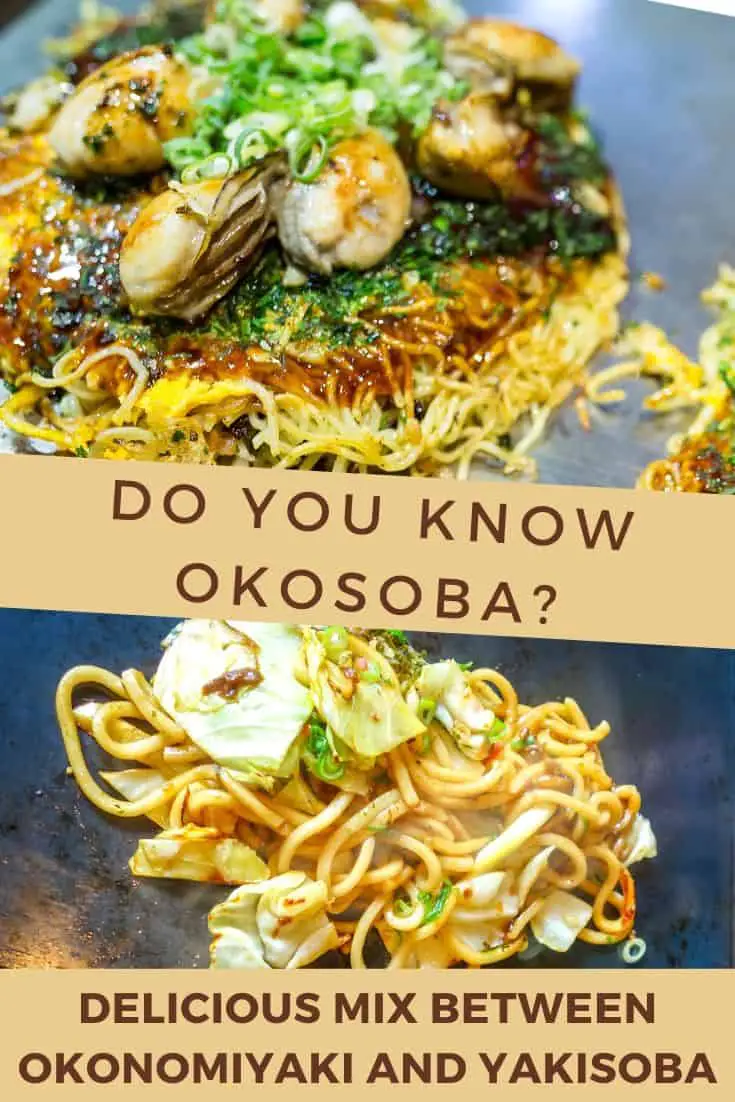What is Okosoba? Have you ever had this okono-yakisoba mix?
Okosoba is a Japanese dish that originated in Osaka, Japan. It is a mixture of okonomiyaki and yakisoba.
Now we know what you’re probably thinking…what the heck is okonomiyaki and yakisoba? Good question.
Let’s take a look at all these dishes to figure out what you can expect when you order okosoba the next time you are dining in a Japanese restaurant.


Check out our new cookbook
Bitemybun's family recipes with complete meal planner and recipe guide.
Try it out for free with Kindle Unlimited:
Read for freeIn this post we'll cover:
It All Started at Botejyu
Botejyu is Japan’s pioneer okosoba and okonomiyaki specialty restaurant chain. It opened in Tamade, Osaka back in 1946.
During this time, the city was struggling to recover after the war ended and they were faced with a food shortage.
In order to keep up, the owner invented a dish called okonomiyaki which basically consisted of whatever ingredients you had on hand.
When Japan started improving economically, the restaurant owner got a bit braver and began expanding his menu.
One dish he introduced was okosoba which is basically a cross between okonomiyaki and yakisoba.
Today, the restaurant also serves tempura, ramen, Takoyaki, wagyu beef, gyoza, katsu, and more.
Here, Planet Great takes a look at Botejyu:
What is Okonomiyaki?
Now let’s start by looking at the dishes okosoba was derived from.
Okonomiyaki is a Japanese savory pancake. Its name was derived from the word okonomi which means ‘how you like’ or ‘what you like’.
True to its name, the ingredients can vary by region.
When the dish is served Kansai style, the batter is made from flour, grated nagaimo (a type of yam), water, eggs, and cabbage.
Other ingredients can be added such meats vegetables or cheeses. In this way, okonomiyaki is a bit like a pizza or an omelet.
In Hiroshima, the ingredients are layered instead of mixed. Typically, they consist of batter, cabbage , or pork. Meats and cheeses may be added as well.
In addition to these two primary cuisines, variations of okonomiyaki can be found throughout Japan.
What is Yakisoba?
Translated literally, yakisoba means fried buckwheat. However, the noodles used are actually made from wheat flour.
They are then flavored with a sauce that is not unlike Worcestershire sauce.
The meal is prepared by frying ramen style noodles with pieces of pork and vegetables that are then flavored with yakisoba sauce, pepper, and salt.
What is Okosoba?
Now that you understand what Okonomiyaki and yakisoba are, you may still be wondering what okosoba is.
After all, the combination of noodles and pancakes is not one you see in many cuisines. Yet, that’s exactly what it is.
Also called modanyaki, the meal can be made by
- combining everything you need for your pancakes including flour, water and whatever types of meat, veggies and sauces you want to throw in.
- Then prepare noodles as desired.
- Pour part of the batter into a pan and pour the noodles on top. Then pour the remainder of the batter over the noodles.
This produces a type of pancake sandwich with noodles in the middle. You can then add pork or any other toppings you desire. The dish is served hot.
You can vary the dish by putting noodles on top or adding the ingredients of your choice.
Botejyu has a variety of interesting options including
- Mixed Seafood Okosoba,
- Cheese Okosoba,
- Bacon and Cheese Okosoba,
- Traditional Okosoba
- and more.
Okosoba is an interesting dish. Born out of necessity, it has become an exotic specialty that can be made in a variety of ways.
What is your preference when eating this unusual meal?
Check out our new cookbook
Bitemybun's family recipes with complete meal planner and recipe guide.
Try it out for free with Kindle Unlimited:
Read for freeJoost Nusselder, the founder of Bite My Bun is a content marketer, dad and loves trying out new food with Japanese food at the heart of his passion, and together with his team he's been creating in-depth blog articles since 2016 to help loyal readers with recipes and cooking tips.
